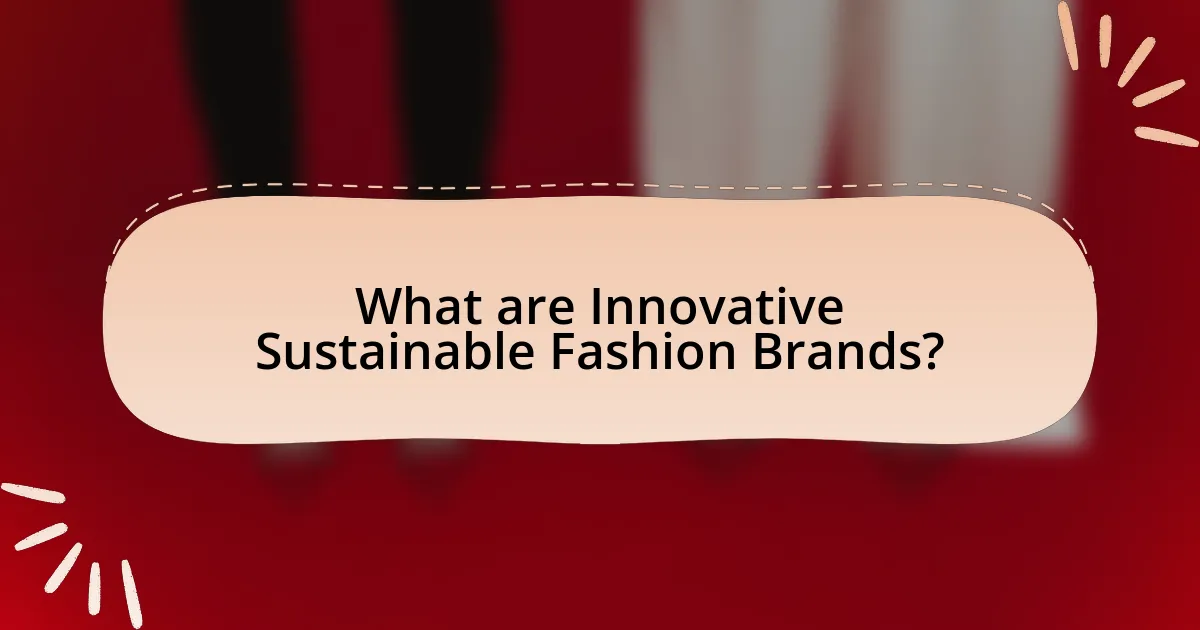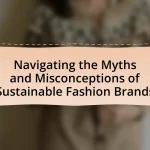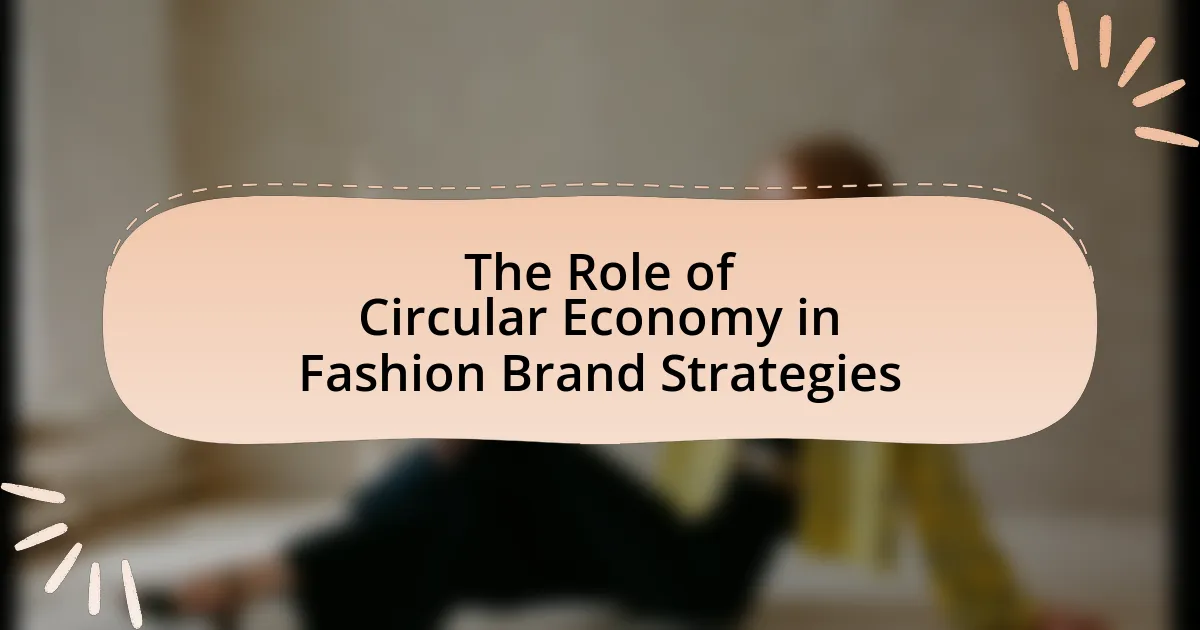Innovative sustainable fashion brands are companies that prioritize eco-friendly practices and ethical production methods in their clothing lines. This article explores the characteristics that distinguish these brands from traditional fashion companies, highlighting their commitment to sustainability through the use of organic and recycled materials, ethical labor practices, and circular fashion initiatives. It also examines the principles guiding these brands, their impact on consumer behavior, and the challenges they face in the market. Notable examples such as Stella McCartney, Patagonia, and Reformation are discussed, along with strategies consumers can adopt to support sustainable fashion.

What are Innovative Sustainable Fashion Brands?
Innovative sustainable fashion brands are companies that prioritize environmentally friendly practices and ethical production methods in their clothing lines. These brands often utilize sustainable materials, such as organic cotton, recycled fabrics, and biodegradable textiles, to minimize their ecological footprint. For example, brands like Stella McCartney and Reformation have gained recognition for their commitment to sustainability, employing transparent supply chains and reducing waste through circular fashion initiatives. The rise of these brands reflects a growing consumer demand for responsible fashion choices, with a report from McKinsey & Company indicating that 67% of consumers consider sustainability when making a purchase.
How do these brands differ from traditional fashion brands?
Innovative sustainable fashion brands differ from traditional fashion brands primarily in their commitment to environmental and social responsibility. These brands prioritize eco-friendly materials, ethical labor practices, and sustainable production processes, contrasting with traditional brands that often focus on fast fashion and mass production. For instance, brands like Patagonia and Reformation utilize recycled materials and promote transparency in their supply chains, which is a significant departure from the practices of many conventional fashion companies that may prioritize profit over sustainability. This shift reflects a growing consumer demand for ethical consumption, as evidenced by a 2021 McKinsey report indicating that 67% of consumers consider sustainability when making a purchase.
What principles guide innovative sustainable fashion brands?
Innovative sustainable fashion brands are guided by principles such as environmental responsibility, ethical labor practices, and circularity. Environmental responsibility emphasizes the use of eco-friendly materials and processes to minimize ecological impact; for instance, brands like Stella McCartney utilize organic cotton and recycled polyester. Ethical labor practices ensure fair wages and safe working conditions for workers, as seen in companies like Everlane, which promotes transparency in its supply chain. Circularity focuses on creating products designed for longevity and recyclability, exemplified by brands like Reformation, which encourages customers to recycle their garments. These principles collectively drive the mission of sustainable fashion brands to create a positive impact on both society and the environment.
How do these brands address environmental concerns?
These brands address environmental concerns by implementing sustainable practices throughout their supply chains. For instance, many utilize eco-friendly materials such as organic cotton, recycled polyester, and Tencel, which reduce the environmental impact of production. Additionally, brands often adopt circular economy principles, encouraging recycling and upcycling of garments to minimize waste. A notable example is Patagonia, which has committed to using 100% recycled materials in its products by 2025. Furthermore, brands like Reformation track their carbon footprint and water usage, providing transparency to consumers and promoting responsible consumption. These initiatives demonstrate a proactive approach to mitigating environmental harm in the fashion industry.
Why is it important to spotlight these brands?
Spotlighting innovative sustainable fashion brands is crucial because it raises awareness about environmentally friendly practices and promotes ethical consumerism. By highlighting these brands, consumers are informed about alternatives to fast fashion, which is known for its negative environmental impact, such as contributing to 92 million tons of waste annually, according to the United Nations. Furthermore, showcasing these brands encourages industry-wide change by setting benchmarks for sustainability and inspiring other companies to adopt similar practices, ultimately leading to a more sustainable fashion ecosystem.
What impact do they have on the fashion industry?
Innovative sustainable fashion brands significantly influence the fashion industry by promoting eco-friendly practices and challenging traditional manufacturing processes. These brands prioritize sustainability through the use of organic materials, ethical labor practices, and reduced waste, which encourages larger companies to adopt similar practices. For instance, brands like Stella McCartney and Patagonia have set benchmarks for environmental responsibility, leading to increased consumer awareness and demand for sustainable options. This shift is supported by a 2021 McKinsey report indicating that 67% of consumers consider sustainability when making a purchase, demonstrating the growing impact of these brands on consumer behavior and industry standards.
How do they influence consumer behavior towards sustainability?
Innovative sustainable fashion brands influence consumer behavior towards sustainability by promoting eco-friendly practices and transparency in their supply chains. These brands often utilize marketing strategies that emphasize the environmental impact of their products, such as using organic materials, reducing waste, and ensuring fair labor practices. For instance, a study by Nielsen found that 66% of global consumers are willing to pay more for sustainable brands, indicating a strong consumer preference for environmentally responsible products. Additionally, brands that engage in storytelling about their sustainability efforts can create emotional connections with consumers, further driving their purchasing decisions towards sustainable options.

Which Innovative Sustainable Fashion Brands are Leading the Way?
Innovative sustainable fashion brands leading the way include Stella McCartney, known for its commitment to cruelty-free materials and eco-friendly practices, and Patagonia, which emphasizes environmental activism and uses recycled materials in its products. Other notable brands are Reformation, which focuses on sustainable manufacturing processes and transparency, and Eileen Fisher, recognized for its circular economy initiatives and organic fabrics. These brands exemplify leadership in sustainable fashion through their innovative approaches and dedication to reducing environmental impact.
What are some notable examples of these brands?
Notable examples of innovative sustainable fashion brands include Patagonia, known for its commitment to environmental activism and use of recycled materials; Stella McCartney, recognized for luxury fashion without the use of leather or fur; and Allbirds, which focuses on eco-friendly footwear made from natural materials like merino wool and eucalyptus. These brands exemplify sustainability through their practices, such as Patagonia’s pledge to donate a percentage of profits to environmental causes, Stella McCartney’s use of organic cotton and innovative materials, and Allbirds’ carbon-neutral production processes.
How do these brands incorporate sustainability into their designs?
These brands incorporate sustainability into their designs by utilizing eco-friendly materials, implementing ethical production practices, and promoting circular fashion. For instance, many brands opt for organic cotton, recycled polyester, and biodegradable fabrics, which significantly reduce environmental impact. Additionally, they often ensure fair labor practices and transparency in their supply chains, aligning with ethical standards. Brands also focus on circularity by designing products that can be easily recycled or upcycled, thereby minimizing waste. This approach is supported by data indicating that the fashion industry contributes to 10% of global carbon emissions, highlighting the importance of sustainable practices in reducing environmental harm.
What unique materials do they use in their products?
Innovative sustainable fashion brands utilize unique materials such as organic cotton, Tencel, and recycled polyester in their products. Organic cotton is grown without synthetic pesticides or fertilizers, promoting environmental health. Tencel, made from sustainably sourced wood pulp, is biodegradable and produced in a closed-loop process that minimizes waste. Recycled polyester, derived from post-consumer plastic bottles, reduces reliance on virgin materials and diverts waste from landfills. These materials not only enhance the sustainability of fashion products but also align with eco-conscious consumer preferences.
What innovative practices do these brands employ?
Innovative sustainable fashion brands employ practices such as circular design, which focuses on creating products that can be reused, recycled, or composted at the end of their life cycle. For instance, brands like Stella McCartney utilize biodegradable materials and promote a zero-waste philosophy, ensuring that their production processes minimize environmental impact. Additionally, companies like Reformation implement transparent supply chains, allowing consumers to track the sustainability of their garments, which fosters accountability and encourages responsible consumption. These practices not only reduce waste but also engage consumers in the sustainability movement, demonstrating a commitment to environmental stewardship.
How do they utilize technology to enhance sustainability?
Innovative sustainable fashion brands utilize technology to enhance sustainability by implementing advanced materials, digital design tools, and supply chain transparency. For instance, brands like Stella McCartney use biodegradable fabrics and recycled materials, reducing waste and environmental impact. Additionally, 3D printing technology allows for on-demand production, minimizing overproduction and excess inventory. Furthermore, blockchain technology is employed to ensure supply chain transparency, enabling consumers to trace the origin of materials and verify ethical practices. These technological advancements collectively contribute to a more sustainable fashion industry by reducing resource consumption and promoting responsible sourcing.
What role does transparency play in their business models?
Transparency is crucial in the business models of innovative sustainable fashion brands as it fosters trust and accountability with consumers. These brands often disclose their supply chain practices, sourcing materials, and production processes, which allows consumers to make informed choices aligned with their values. For instance, brands like Everlane and Patagonia openly share information about their factories and environmental impact, demonstrating their commitment to ethical practices. This level of transparency not only enhances brand loyalty but also encourages industry-wide changes towards sustainability, as consumers increasingly demand ethical standards from all fashion brands.

How can consumers support Innovative Sustainable Fashion Brands?
Consumers can support innovative sustainable fashion brands by choosing to purchase their products, thereby directly contributing to their growth and sustainability efforts. By prioritizing brands that utilize eco-friendly materials, ethical labor practices, and transparent supply chains, consumers can drive demand for sustainable practices in the fashion industry. Research indicates that the global sustainable fashion market is projected to reach $8.25 billion by 2023, highlighting the increasing consumer interest in sustainable options. Additionally, consumers can engage with these brands on social media, share their values, and advocate for sustainable practices, further amplifying their impact.
What are the best practices for choosing sustainable fashion?
The best practices for choosing sustainable fashion include prioritizing brands that use eco-friendly materials, ensuring ethical labor practices, and supporting circular fashion initiatives. Eco-friendly materials, such as organic cotton, Tencel, and recycled fabrics, reduce environmental impact by minimizing resource consumption and pollution. Ethical labor practices involve fair wages and safe working conditions, which are essential for social sustainability. Supporting circular fashion initiatives, like clothing rental, resale, and recycling programs, helps reduce waste and promotes a more sustainable lifecycle for garments. According to the Global Fashion Agenda’s 2021 report, sustainable practices can significantly reduce the fashion industry’s carbon footprint, emphasizing the importance of these best practices.
How can consumers identify truly sustainable brands?
Consumers can identify truly sustainable brands by examining their transparency, certifications, and supply chain practices. Brands that openly share information about their sourcing, production processes, and environmental impact demonstrate a commitment to sustainability. Certifications such as Fair Trade, Global Organic Textile Standard (GOTS), and the Responsible Wool Standard (RWS) provide third-party validation of a brand’s sustainable practices. Additionally, brands that prioritize ethical labor practices and use eco-friendly materials, such as organic cotton or recycled fibers, further indicate their sustainability. Research shows that consumers increasingly prefer brands with clear sustainability commitments, as evidenced by a 2021 Nielsen report indicating that 73% of global consumers are willing to change their consumption habits to reduce environmental impact.
What are the benefits of investing in sustainable fashion?
Investing in sustainable fashion offers environmental, social, and economic benefits. Environmentally, sustainable fashion reduces waste and pollution by promoting eco-friendly materials and production processes, which can significantly lower carbon emissions; for instance, the fashion industry is responsible for about 10% of global carbon emissions, and sustainable practices can help mitigate this impact. Socially, it supports fair labor practices and improves working conditions for garment workers, as many sustainable brands prioritize ethical sourcing and transparency in their supply chains. Economically, investing in sustainable fashion can lead to long-term savings for consumers and brands alike, as sustainable products often have a longer lifespan and can reduce the costs associated with fast fashion’s disposable nature.
What challenges do these brands face in the market?
Innovative sustainable fashion brands face significant challenges in the market, primarily including high production costs, consumer awareness, and competition from fast fashion. High production costs arise from sourcing sustainable materials and implementing ethical labor practices, which can lead to higher retail prices compared to conventional brands. Consumer awareness is another challenge, as many potential customers may not fully understand the benefits of sustainable fashion or may prioritize price over sustainability. Additionally, competition from fast fashion brands, which offer trendy items at lower prices and faster turnaround times, makes it difficult for sustainable brands to capture market share. These challenges are supported by industry reports indicating that sustainable fashion brands often struggle to scale due to these economic and market pressures.
How do they overcome barriers to consumer awareness?
Innovative sustainable fashion brands overcome barriers to consumer awareness by leveraging digital marketing strategies and engaging storytelling. These brands utilize social media platforms to reach wider audiences, creating visually appealing content that highlights their sustainable practices and ethical sourcing. For instance, brands like Reformation and Patagonia effectively use Instagram to showcase their eco-friendly products and share their brand narratives, which resonate with environmentally conscious consumers. Additionally, collaborations with influencers and participation in sustainability-focused events further enhance visibility and educate consumers about the importance of sustainable fashion, thereby increasing awareness and driving consumer engagement.
What strategies do they use to compete with fast fashion?
Innovative sustainable fashion brands compete with fast fashion by emphasizing ethical production, eco-friendly materials, and transparency in their supply chains. These brands often utilize slow fashion principles, focusing on quality over quantity, which appeals to consumers seeking sustainable alternatives. For instance, brands like Patagonia and Reformation prioritize sustainable sourcing and fair labor practices, which resonate with environmentally conscious shoppers. Additionally, many of these brands engage in storytelling and community-building to foster a loyal customer base, highlighting their commitment to sustainability and social responsibility. This approach not only differentiates them from fast fashion but also aligns with the growing consumer demand for ethical fashion choices.
What practical steps can consumers take to promote sustainable fashion?
Consumers can promote sustainable fashion by choosing to buy from brands that prioritize eco-friendly practices and materials. By supporting companies that use organic fabrics, recycled materials, and ethical labor practices, consumers directly influence the market demand for sustainable products. Research indicates that the global sustainable fashion market is projected to reach $8.25 billion by 2023, reflecting a growing consumer preference for environmentally responsible options. Additionally, consumers can reduce their fashion footprint by buying second-hand clothing, participating in clothing swaps, and properly recycling garments, which helps minimize waste and extends the lifecycle of fashion items.




